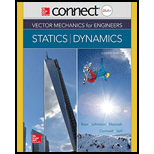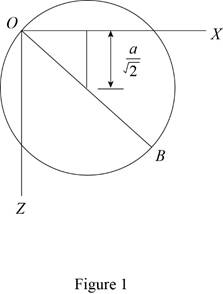
Concept explainers
(a)
Find the principal moment of inertia at the origin O.
(a)
Answer to Problem 9.179P
The principal moment of inertia at the origin O is
Explanation of Solution
Given information:
The mass of the cylinder is denoted by m.
The length of the circular cylinder is denoted by a.
The diameter OB of the top surface makes
Calculation:
Show the homogeneous circular cylinder as shown in Figure 1.

Refer Figure 1.
Refer Figure 9.28.
Apply parallel axis theorem
Show the moment of inertia of the circular cylinder about the y axis as follows:
Show the moment of inertia of the circular cylinder about the x and z axis as follows:
Here, a is the radius of the cylinder and L is the length of the cylinder.
Substitute
The centroidal axis products of inertia are zero due to symmetry.
Write the centroidal locations as measured from the origin O along the x, y and z axis as below;
Express the moment of inertia
Express the moment of inertia
Express the moment of inertia
Show the Equation 9.56 as follows:
Substitute
Substitute
Solve the above Equation and get the values of
Show the principal moment of inertia as follows:
Thus, the principal mass moment of inertia are
(b)
Find the angles made by the principal axis of inertia at O with the coordinate axis.
(b)
Answer to Problem 9.179P
The angles made by the principal axis of inertia at O with the coordinate axis is
Explanation of Solution
Given information:
Consider the direction cosines of each principal axis are denoted by
Calculation:
Refer Part (a).
Show the Equation 9.54 as follows:
Substitute
Modify Equation (3).
Consider
Solve Equation (4).
Add both the Equation in Equation (4).
Substitute
Show the Equation 9.57 as follows:
Substitute
Consider K1.
Substitute
Calculate the value of
Substitute
Show the direction cosines
Conisder K3.
Substitute
Calculate the value of
Substitute
Show the direction cosines
Consider K2.
Show the Equation 9.54b as follows:
Substitute
Refer Equation (3) and (6).
Substitute
Modify above Equations as follows:
Solve Equation (8) and get the value of
Show the Equation 9.57 as follows:
Substitute
Show the direction cosines
Thus, the velocity of the point B is
(c)
Sketch the body and show the orientation of the principal axis of inertia relative to x, y, and z axis.
(c)
Explanation of Solution
Given information:
Calculation:
Refer Part (a) and (b).
Sketch the body and show the orientation of the principal axis of inertia relative to x, y, and z axis as shown in Figure 2.

Refer Figure 2.
The principal axis 1 and 3 lies on the vertical plane of symmetry passing through OB.
The principal axis 2 lies in xz plane.
Want to see more full solutions like this?
Chapter 9 Solutions
Connect 2 Semester Access Card for Vector Mechanics for Engineers: Statics and Dynamics
- Calculate the mass moment of inertia of the thin ring shown in the accompanying diagram. Express your answer in kg m2 ⋅ .arrow_forwardThe thin plate shown is composed of a square plate of mass 80 kg and a quarter-circular plate of mass 50 kg. What is the mass moment of inertia of the shape about the y-axis?arrow_forwardThe homogeneous circular cone shown has a mass m . Determine the mass moment of inertia of the cone with respect to the line joining the origin O and pont A.arrow_forward
- Calculate the moment of inertia of a rectangular slab, of sides 0.24 metres by 0.47 metres and mass 2.86 kg rotating about an axis through the centre of the slab, and perpendicular to the slabarrow_forwardThe area shown is revolved about the x axis to form a homogeneous solid of revolution of mass m . Determine by direct integration the mass moment of inertia of the solid with respect to (a) the x axis, (b) the y axis. Express your answers in terms of m and the dimensions of the solid.arrow_forwardCalculate the moment of inertia for a cube of mass 7 kg and lenghts 260 mm, when rotating about one of the edges .arrow_forward
- A thin, semielliptical plate has a mass m . Determine the mass moment of inertia of the plate with respect to (a) the centroidal axis BB, (b) the centroidal axis CC ’ that is perpendicular to the plate.arrow_forwardA homogenous thin square plate shown has a mass of 60 kg. What is the mass moment of inertia of the square plate shown about the x-axis and y-axis?arrow_forwardThe mass moment if inertia of a cylinder about its central axis perpendicular to a circular cross section isarrow_forward
- Thin aluminum wire of uniform diameter is used to form the figure shown. Denoting the mass per unit length of the wire by m’, determine the mass products of inertia Ixy, Iyz, and Izx of the wire figure.arrow_forwardA thin plate is shown and it is composed of a square plate which has a mass of 102 kg and a quarter circle plate which has mass 60 kg.1) Find the mass moment of inertia of ONLY THE SQUARE PLATE about the y-axis (Imagine there is no quarter circle plate yet).Choices: 22.5 kg-m^2, 45.0 kg-m^2, 5.63 kg-m^2, 1.125 kg-m^22) Find the mass moment of inertia of the entire shape about the x-axis.Choices: 9.43 kg-m^2, 76.5 kg-m^2, 110.2 kg-m^2, 33.8 kg-m^23) Find the mass moment of inertia of the entire shape about the y-axis.Show complete solutions please, I want to learn how to solve these items.arrow_forwardFind the moments of inertia (J1,J2) of a homogeneous ring of circular shape with respect to both axes. The mass and radius (m,R) of the ring are knownarrow_forward
 Elements Of ElectromagneticsMechanical EngineeringISBN:9780190698614Author:Sadiku, Matthew N. O.Publisher:Oxford University Press
Elements Of ElectromagneticsMechanical EngineeringISBN:9780190698614Author:Sadiku, Matthew N. O.Publisher:Oxford University Press Mechanics of Materials (10th Edition)Mechanical EngineeringISBN:9780134319650Author:Russell C. HibbelerPublisher:PEARSON
Mechanics of Materials (10th Edition)Mechanical EngineeringISBN:9780134319650Author:Russell C. HibbelerPublisher:PEARSON Thermodynamics: An Engineering ApproachMechanical EngineeringISBN:9781259822674Author:Yunus A. Cengel Dr., Michael A. BolesPublisher:McGraw-Hill Education
Thermodynamics: An Engineering ApproachMechanical EngineeringISBN:9781259822674Author:Yunus A. Cengel Dr., Michael A. BolesPublisher:McGraw-Hill Education Control Systems EngineeringMechanical EngineeringISBN:9781118170519Author:Norman S. NisePublisher:WILEY
Control Systems EngineeringMechanical EngineeringISBN:9781118170519Author:Norman S. NisePublisher:WILEY Mechanics of Materials (MindTap Course List)Mechanical EngineeringISBN:9781337093347Author:Barry J. Goodno, James M. GerePublisher:Cengage Learning
Mechanics of Materials (MindTap Course List)Mechanical EngineeringISBN:9781337093347Author:Barry J. Goodno, James M. GerePublisher:Cengage Learning Engineering Mechanics: StaticsMechanical EngineeringISBN:9781118807330Author:James L. Meriam, L. G. Kraige, J. N. BoltonPublisher:WILEY
Engineering Mechanics: StaticsMechanical EngineeringISBN:9781118807330Author:James L. Meriam, L. G. Kraige, J. N. BoltonPublisher:WILEY





